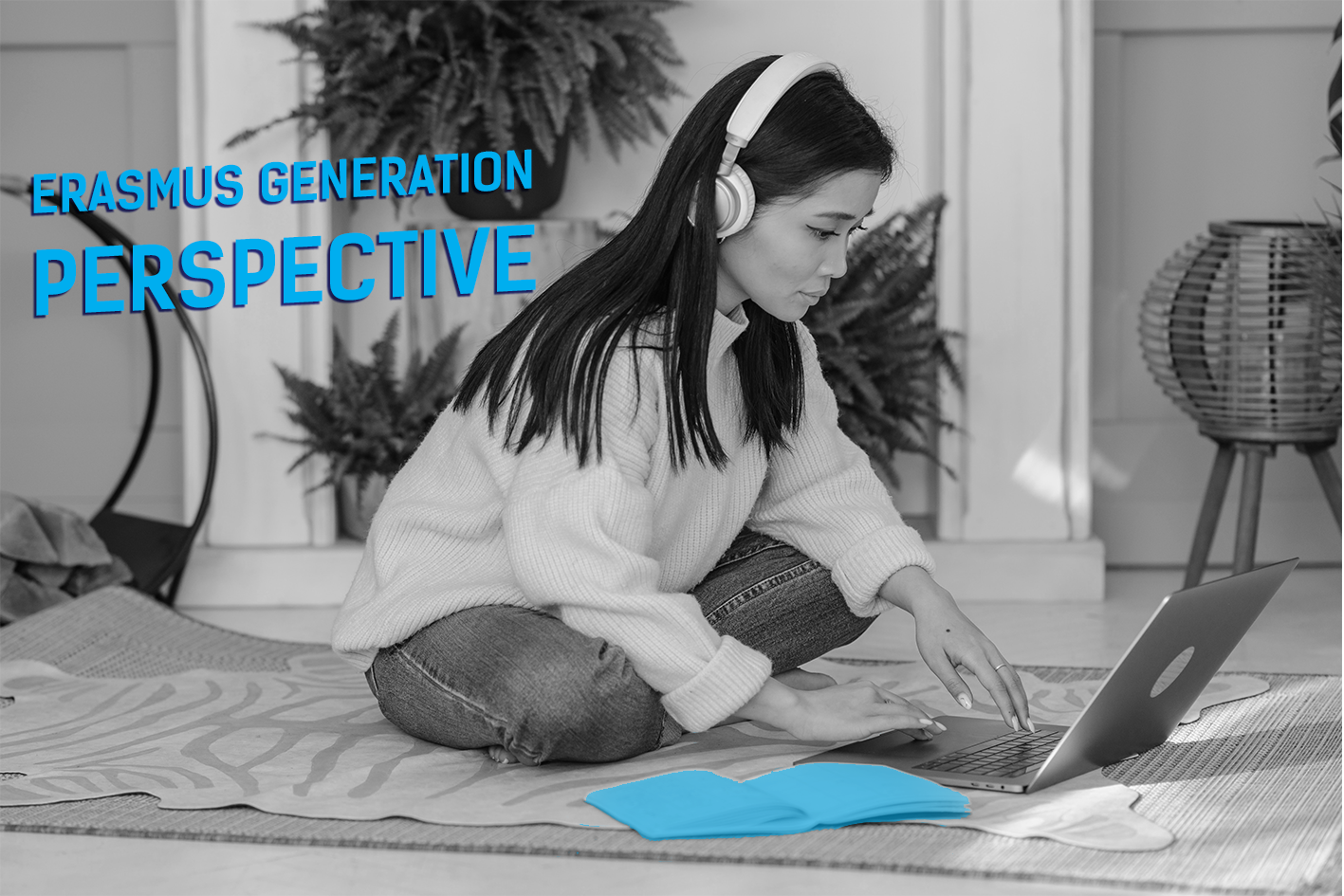
* Erasmus Generation Perspective articles are written by ESN volunteers with the aim to share the student voice on current policy developments in the field of international education. The text represents the individual perspective of the author and not an official statement of the Erasmus Student Network.
One year on since the Covid-19 pandemic first swept through Europe, causing 95% of universities to close campuses and adopt distance learning, higher education institutions find themselves at a crossroads (EUA, 2020). Will universities join schools in their efforts to reopen sites and return students to in person teaching as soon as possible? Or will they follow in the footsteps of companies such as Siemens, Facebook and Amazon who are using this opportunity to introduce long-term working from home setups? Is there a future for face-to-face interactions in higher education?
As is often the case with crises, the pandemic has forced change, creativity and reflection within society, education included. Before the covid-crisis, an estimated 70% of university academics across Europe had never taught online, however now 87% of institutions are open to exploring new ways of teaching (EUA, 2020). Even if Covid-19 does not see the end of face-to-face university life, it has certainly led universities to consider the alternatives. And virtual learning is not without its strengths. Educational research into online learning has repeatedly shown equal if not greater academic success for students learning through virtual platforms (Dolan, 2008). There are even suggestions that online learning creates richer learning environments and experiences, incorporating technologies such as online discussion boards, breakout rooms and increased accessibility to lecturer office hours.
It is further possible that online learning may be more appropriate considering recent research and developments within the science of learning. We are increasingly aware of attention limits with smaller chunks of learning such as 20-minute periods leading to deeper consolidation of knowledge compared to three-hour lecture blocks (Giabbanelli, 2009). Additionally, different individuals find their peak concentration occurs at different points of the day with some students best able to study in the evenings whereas others may prefer the morning. The flexibility of online learning is thus a great benefit to the student body. We may now watch our lectures at the time best suited to ourselves, pausing and rewatching as appropriate to ensure lecture content is fully understood in bite-sized chunks. Add to this the loss of commuting time from the university day and online learning allows students to schedule each day as best fits their style of learning and work-life balance.
Online learning thus seems to offer fresh and beneficial directions for higher education where students can learn in engaging and convenient ways. However, the world away from face-to-face teaching does come with criticism. The main concerns regard the loss of human contact and academic dialogue if universities were to become entirely digital (Giabbanelli, 2009). As students adjust to the new normality of remote education, the first loss was that of learning communities. Seemingly trivial chit-chat between lecture friends was suddenly highlighted as a key tool for checking to understand and consolidate new learning. Learning alone, students were missing out on valuable interactions (Jeffery and Bauer, 2020). The distance between instructor and student also created issues, communication relies on so much more than the verbal component but body language, facial expressions, and responses from the listener all become at risk when content is moved from campus.
Not only are students in danger of losing contact with academic communities when studying remotely but also the lively discussions that accompany them. It has been long established in education that understanding beyond surface-level knowledge, that of independent, flexible and critical thinking, requires active learning (Freire, 2018). Whether this involves seminar debates, laboratory work or presenting to others, students learn best when doing (Jeffery and Bauer, 2020). If online learning focuses only on transmitting module content, it may fail in producing engaged and curious minds, the kind of problem-solvers who have worked tirelessly to carry our society through this pandemic (Symonds, 2014).
Yet this may not be the final damnation of online learning but rather a concern for all higher education. Indeed, the issues of keeping students engaged through online learning and potential loss of contact may be resolved if the transition away from in-person tuition is thoroughly and thoughtfully planned, builds a learning eco-system, and develops skills and positive attitudes required to fully embrace and optimise the new style of education (Jeffrey and Bauer, 2020; Hidges et al, 2020; Ginns and Ellis, 2007). Meanwhile, there may be countless lecture theatres across Europe filled with students who are passively receiving knowledge, such transmissions of information rarely able to produce the quality of thinkers needed for tomorrow (Symonds, 2014). Maybe the issue lies not in where but how our students are receiving their education?
The pandemic has illuminated the full capacity of online learning, both in equalling, outshining and falling short of face-to-face tuition. But at the same time, the coronavirus crisis has reminded us of the duty of education in creating innovative problem-solvers for future crises. Both digital and in-person teaching has the potential to create these minds, but only if they recognise the importance and ensure the success of active and critical learning.
However, the discussion between online and in-person teaching misses one key factor: life beyond studying. University life encompasses so much more than lectures, seminars and exams. The small daily interactions and wider experiences that accompany face to face tuition are able to shape our minds and boost our energy levels in a way that online learning is yet to succeed in replicating. If the pedagogical value of virtual and in-person education is equal then the decision comes down to the quality of human connection we seek from university life. Faced with such a challenge, can a screen ever compete with face-to-face?
Links:
“When will schools reopen?” - EuroTopics https://www.eurotopics.net/en/253953/when-will-schools-reopen
“Siemens Says That 140,000 Of Its Employees Can Work From Anywhere” - Forbes https://www.forbes.com/sites/jackkelly/2020/07/27/siemens-says-that-140000-of-its-employees-can-work-from-anywhere/?sh=38b683356a44
“European higher education in the Covid-19 Crisis” - European University Association https://eua.eu/downloads/publications/briefing_european%20higher%20education%20in%20the%20covid-19%20crisis.pdf
References:
Dolan, K. (2008), “Comparing Modes of Instruction: The Relative Efficacy of On-Line and In-Person Teaching for Student Learning” - doi: 10.1017/S1049096508080608
Giabbanelli, P.J. (2009), “Why having in-person lectures when e-learning and podcasts are available?” - https://dl.acm.org/doi/pdf/10.1145/1536274.1536288?casa_token=J13c2d4kEoMAAAAA%3AK-KzwwjHzyrhJRl4oRXB_oNpTGDwVQBAEMERBbanl9jq8UB4ZxDVXZBGwNIifNe9wrqiKZ6Ch_ZA1QI
Symonds, M.R.E. (2014) “Lecturing and other face-to-face teaching – too much or too little? An assessment based on student feedback and fail rates” - https://www.tandfonline.com/doi/abs/10.1080/07294360.2014.911256
Freire, P. (2018) ‘Pedagogy of the Oppressed’ - Penguin Modern Classics
Jeffery, K.A., Bauer, C.F. (2020) “Students’ Responses to Emergency Remote Online Teaching Reveal Critical Factors for All Teaching” - https://pubs-acs-org.ezproxyd.bham.ac.uk/doi/pdf/10.1021%2Facs.jchemed.0c00736
Hodges,C., Moore, S., Lockee, B., Trust, T., Bond, A. (2020) “The Difference Between Emergency Remote Teaching and Online Learning” - http://www.cetla.howard.edu/workshops/docs/The%20Difference%20Between%20Emergency%20Remote%20Teaching%20and%20Online%20Learning%20_%20EDUCAUSE%20(2).pdf

Follow ESN